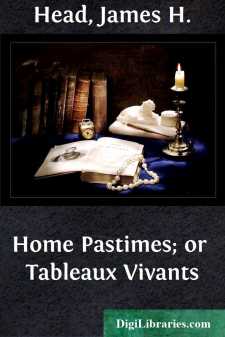Categories
- Antiques & Collectibles 13
- Architecture 36
- Art 48
- Bibles 22
- Biography & Autobiography 813
- Body, Mind & Spirit 142
- Business & Economics 28
- Children's Books 15
- Children's Fiction 12
- Computers 4
- Cooking 94
- Crafts & Hobbies 4
- Drama 346
- Education 46
- Family & Relationships 57
- Fiction 11828
- Games 19
- Gardening 17
- Health & Fitness 34
- History 1377
- House & Home 1
- Humor 147
- Juvenile Fiction 1873
- Juvenile Nonfiction 202
- Language Arts & Disciplines 88
- Law 16
- Literary Collections 686
- Literary Criticism 179
- Mathematics 13
- Medical 41
- Music 40
- Nature 179
- Non-Classifiable 1768
- Performing Arts 7
- Periodicals 1453
- Philosophy 64
- Photography 2
- Poetry 896
- Political Science 203
- Psychology 42
- Reference 154
- Religion 513
- Science 126
- Self-Help 84
- Social Science 81
- Sports & Recreation 34
- Study Aids 3
- Technology & Engineering 59
- Transportation 23
- Travel 463
- True Crime 29
Home Pastimes; or Tableaux Vivants
by: James H. Head
Categories:
Description:
Excerpt
INTRODUCTION.
The Tableaux Vivants may be new to many of our readers, although they have been produced and have been quite popular in Europe, and to some extent in this country. For public or private entertainment, there is nothing which is so interesting and instructive as the tableau. The person most fitted to take charge of a tableau-company is one who is expert at drawing and painting: any one who can paint a fine picture can produce a good tableau.
The individual who makes all of the necessary arrangements for a series of tableaux is generally called the stage manager. His first work is to select a programme of tableaux; and in this list there should be a variety of designs, comprising the grave, the comic, and the beautiful. A manuscript should be used in which to write the names of the tableaux, directions for forming each, the names of the performers, the parts which they personate, the styles of the costumes, and the quantity and kind of scenery and furniture used in each design.
The following diagram will illustrate the manner in which the manuscript should be arranged:—
After the manuscript is completed, it will be necessary to select the company and assign the parts. The number of persons required in a first-class tableau-company is forty. It will be necessary to have that number to produce large pictures; fifteen or twenty-five persons will be sufficient for smaller representations. In forming the company, the following persons should be selected: six young ladies, of good form and features, varying in styles and sizes; six young gentlemen, of good figure, and of various heights; two small misses; two small lads; two gentlemen for stage assistants; one painter, one joiner, one lady's wardrobe attendant, one gentleman's wardrobe attendant, one curtain attendant, one announcer. If a large piece is to be performed, such as the Reception of Queen Victoria, it will be necessary to have fifteen or twenty young gentlemen, varying from four to five feet in height, to personate military and other figures. Each person should have written instructions in regard to the scenes in which they take a part, giving full descriptions of the costumes, position, expression, and character which they are to personate; after which they should meet in a large room, and go through a private rehearsal. It will be necessary, previously to appearing before the public, to have three rehearsals—two private ones, and one dress rehearsal on the stage. It will be well to have a few friends witness the dress rehearsal, which will give confidence to the performers, previous to their dêbut before a large audience. As soon as the company has been organized, and each performer has received his several programmes, it will be the duty of the stage manager to see that the various branches of the profession are progressing in unison with the rehearsals. Each tableau should be carefully examined, and a list of the machinery, scenery, wardrobe, and furniture of each piece noted down, and competent persons immediately set to work on their completion. The selection of appropriate music, the drafting and erecting of the stage, and many other minor matters, should all be completed, before the tableaux can be produced.
But before proceeding farther, we will give directions in reference to the size and formation of the stage. It should be strongly framed of joist, and covered with smooth boards, and placed at the end of the hall, at equal distances between the side walls. It should be twelve feet square, and six feet in height. The front of the stage should be made to represent a large picture frame; it can be easily made of boards ten inches wide, fastened together in a bevelled manner, and covered with buff cambric, ornamented with gold paper. Oval frames are frequently used, but they are not so easy to arrange and manage as a square frame. Cover the floor of the stage with a dark woollen carpet, drape the ceiling with light blue cambric, the background with black cambric; the sides should be arranged in the same style as the side scenes of a theatrical stage....


